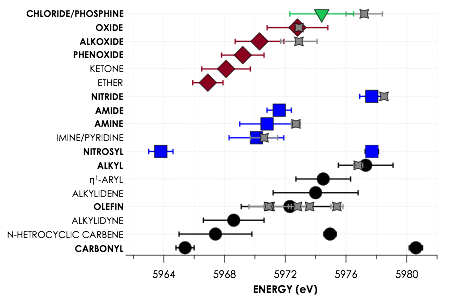Reports: DNI655181-DNI6: Chemically Targeted X-ray Spectroscopic Studies of Chromium-Catalyzed Ethylene Trimerization Reactions
Kyle M. Lancaster, PhD, Cornell University
During the 2015-2016 funding period we pursued X-ray spectroscopic studies of homogeneously catalyzed reactions mediated by transition metals. The goal proposed at the outset of this project concerned the identification of active species within ethylene trimerization reactions employing chromium diphosphene precatalysts. We had originally proposed to use valence-to-core X-ray emission spectroscopy (V2C XES) as a chemically-sensitive probe of the coordination environment around chromium. Before the grant was activated, we had conducted a rigorous calibration study1 of chromium V2C XES. This study found that although the technique is highly sensitive to the identities of coordinated ligands, the other ligands within a complex will perturb V2C XES band energies such that substantial overlap precludes definitive assignment of bands to individual ligands (Figure 1).
Figure 1. Plotted spectrochemical series displaying the average energies of experimentally calibrated, DFT-calculated Kβ″ V2C XES features for ligands grouped by donor atom. Error bars represent doubled standard deviations. Gray points indicate experimental Kβ″ energies corresponding to the indicated ligands, with error bars derived from fits to experimental spectra. Ligands indicated in bold are predicted to significantly contribute intensity to Kβ″ regions, while nonbolded ligands are expected to be difficult to resolve with current experimental limitations. Adapted from Ref 1.
As a result of this discovery, we focused on the use of conventional X-ray absorption spectroscopy to try to differentiate Cr species within these reaction mixtures. We we encouraged by a study from Bercaw and co-workers2 in which they observed by UV/vis spectroscopy clean conversion between the major Cr species in solution when highly soluble variants of Cr bisphosphine precatalysts are used. We followed the reported procedures and, although we reproduced the UV/vis behavior, we did not observe useful changes in the XAS.
In order to achieve progress toward our goal of developing X-ray spectroscopies for use in characterizing species relevant to homogeneous catalysis and small molecule activation, we elected to shift focus to reactions with narrower parameter spaces. Consequently, we have begun studies of late metal complexes that activate dioxygen toward forming species capable of challenging transformations such as selective oxidation of alkanes to make alcohols. To date, we have made progress toward identifying several new motifs in late-metal oxygen species. We have used oxygen K-edge X-ray absorption spectroscopy to characterize several bimetallic and trimetallic late-metal cluster complexes. These species and their reactivity properties will be reported during the 2016-2017 funding period.
Funding from the ACS PRF during the 2015-2016 period has been of tremendous value in helping initiate our research program. We have been able to carry out numerous pilot X-ray spectroscopy studies that have enabled us to develop techniques including valence-to-core X-ray emission spectroscopy (V2C XES, which probes the electronic structures of bound ligands), high energy resolution fluorescence detected X-ray absorption spectroscopy (HERFD XAS, which allows unprecedented resolution of XAS features vital to compound characterization), and light atom K-edge XAS, and resonant inelastic X-ray scattering (RIXS, which uses high energy X-rays to access information that typically requires sample scope-restricting low-energy X-rays). Our combined efforts and perspectives for future studies are summarized in an invited review article that will be submitted in Fall 2016 to ACS Catalysis. In recognition of our rare expertise in these methods, numerous PIs at top-tier institutions have called on us to collaborate.
The majority of expenditures in the 2015-2016 funding period went to support a graduate student, Mr. James Lukens. Mr. Lukens has been able to pursue research without needing to serve as a teach assistant. Consequently, he has been able to develop considerable expertise as an X-ray spectroscopist. Moreover, Mr. Lukens has developed proficiency in chemical synthesis and electronic structure calculations. Funds from ACS PRF have enabled Mr. Lukens to travel to the Stanford Synchrotron Radiation Lightsource to carry out experiments. In addition, Mr. Lukens traveled to the ACS Fall 2016 National Meeting in Philadelphia, where he presented a poster on his ACS PRF-supported work.
1. MacMillan, S. N.; Walroth, R. C.; Perry, D. M.; Morsing, T. J.; Lancaster, K. M. Inorg. Chem. 2014, 54 (1), 205–214.
2. Do, L. H.; Labinger, J. A.; Bercaw, J. E. ACS Catalysis 2013, 3 (11), 2582–2585.












